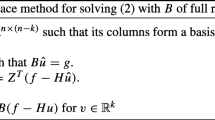Abstract
Linear systems in saddle point form are usually highly indefinite,which often slows down iterative solvers such as Krylov subspace methods. It has been noted by several authors that negating the second block row of a symmetric indefinite saddle point matrix leads to a nonsymmetric matrix \({{\mathcal A}}\) whose spectrum is entirely contained in the right half plane. In this paper we study conditions so that \({{\mathcal A}}\) is diagonalizable with a real and positive spectrum. These conditions are based on necessary and sufficient conditions for positive definiteness of a certain bilinear form,with respect to which \({{\mathcal A}}\) is symmetric. In case the latter conditions are satisfied, there exists a well defined conjugate gradient (CG) method for solving linear systems with \({{\mathcal A}}\). We give an efficient implementation of this method, discuss practical issues such as error bounds, and present numerical experiments.
Similar content being viewed by others
Explore related subjects
Discover the latest articles and news from researchers in related subjects, suggested using machine learning.References
Ashby S.F., Holst M.J., Manteuffel T.A. and Saylor P.E. (2001). The role of the inner product in stopping criteria for conjugate gradient iterations. BIT 41: 26–52
Ashby S.F., Manteuffel T.A. and Saylor P.E. (1990). A taxonomy for conjugate gradient methods. SIAM J. Numer. Anal. 27: 1542–1568
Axelsson O. (1994). Iterative Solution Methods. Cambridge University Press, Cambridge
Benzi M., Golub G.H. and Liesen J. (2005). Numerical solution of saddle point problems. Acta Numer. 14: 1–137
Benzi M. and Simoncini V. (2006). On the eigenvalues of a class of saddle point matrices. Numer. Math. 103: 173–196
Bramble J.H. and Pasciak J.E. (1988). A preconditioning technique for indefinite systems resulting from mixed approximations of elliptic problems. Math. Comp. 50: 1–17
Elman, H.C., Silvester, D.J., Wathen, A.J.:Finite elements and fast iterative solvers: with applications in incompressible fluid dynamics. In: Numerical Mathematics and Scientific Computation. Oxford University Press, New York (2005)
Fischer B., Ramage A., Silvester D.J. and Wathen A.J. (1998). Minimum residual methods for augmented systems. BIT 38: 527–543
Gantmacher F.R. (1959). The Theory of Matrices. Chelsea Publishing Co., New York
Givens W. (1952). Fields of values of a matrix. Proc. Am. Math. Soc. 3: 206–209
Hestenes M.R. and Stiefel E. (1952). Methods of conjugate gradients for solving linear systems. J. Res. Nat. Bur. Stand. 49: 409–436
Householder A.S. (1975). The theory of matrices in numerical analysis (reprint of 1964 edition). Dover Publications Inc., New York
The MathWorks Company. Matlab, version 6.5.http://www.mathworks.com
Paige C.C. and Saunders M.A. (1975). Solution of sparse indefinite systems of linear equations. SIAM J. Numer. Anal. 12: 617–629
Silvester, D.J., Elman, H.C., Ramage, A.: Incompressible Flow Iterative Solution Software (IFISS), version 2.2.http://www.manchester.ac.uk/ifiss
Sleijpen G.L.G., van der Vorst H.A. and Modersitzki J. (2000). Differences in the effects of rounding errors in Krylov solvers for symmetric indefinite linear systems. SIAM J. Matrix Anal. Appl. 22: 726–751
Stoll, M., Wathen, A.: The Bramble–Pasciak preconditioner for saddlepoint problems. Numerical Analysis Group Research Report NA-07/13. Oxford University, Computing Laboratory (2007)
Stoll, M., Wathen, A.: Combination preconditioning and self-adjointness in non-standard inner products with application to saddle point problems. Numerical Analysis Group Research Report NA-07/11. Oxford University, Computing Laboratory (2007)
Author information
Authors and Affiliations
Corresponding author
Additional information
In memory of Gene Golub (1932–2007), our wonderful friend and colleague, who had a great interest in the conjugate gradient method and the numerical solution of saddle point problems.
The work of Jörg Liesen was supported by the Emmy Noether-Program and the Heisenberg-Program of the Deutsche Forschungsgemeinschaft.
Rights and permissions
About this article
Cite this article
Liesen, J., Parlett, B.N. On nonsymmetric saddle point matrices that allow conjugate gradient iterations. Numer. Math. 108, 605–624 (2008). https://doi.org/10.1007/s00211-007-0131-9
Received:
Revised:
Published:
Issue Date:
DOI: https://doi.org/10.1007/s00211-007-0131-9




